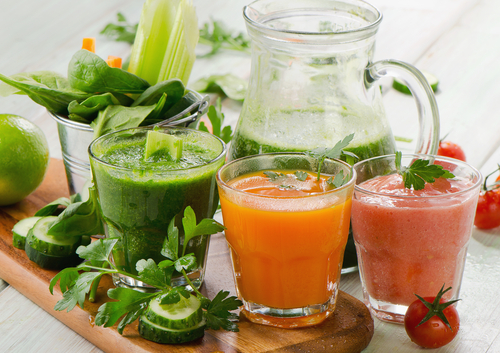8 Tricks to Healthy Juices and Smoothies
By Cordialis Msora-KasagoPublished: November 18, 2014

If you are like most people, getting the daily recommended 5-9 servings of fruits and vegetables is a chore. Regardless of how you plate your meals, you always seem to fall short of the recommended amounts. One of the latest trends in nutrition and healthy eating is to take fruits and vegetables in liquid form as either a smoothie (blended) or juice. If you are thinking of partaking in the trend, here are some tips for success.
1. Less fruit, more veggies. If the goal is to eat more fruits and vegetables, adding a whole pineapple to your juice or smoothie is a great idea, right? Wrong! Although healthy, fruit can be a concentrated source of calories and juicing too much fruit can lead to excessive caloric intakes. Make sure that your juice or smoothie remains relatively low in calories by using mostly vegetables and adding a little fruit for sweetness.
2. Make it bright and colorful. Nutritionists tout the importance of “eating a rainbow” to ensure that you are getting a wide variety of nutrients. From the yellows and oranges of carrots and mangoes to the blues and purples of grapes and blueberries or the vibrant greens of apples, limes, and leafy vegetables, there is certainly no shortage of essential nutrients when you add variety to your smoothies or juices. Add them all and enjoy the tastes of nature’s candy.
3. Don’t throw away the fiber. If you are blending for smoothies, chances are you continue to reap the benefits of the fiber from the produce. However, if you are juicing, you are most likely throwing out valuable fiber with each glass you chug down. Gather all the pulp left after you are done making your juice and consider adding a little of it back to your juice or save the entire pulp to use in baked foods.
4. Use what’s in season. Reduce expense by using locally available produce that is in season in your area. The easy accessibility of these fruits and vegetables not only saves you money but also gives you the best buck for your nutrient needs. Studies tell us that produce begins to lose nutritional value from the time that it is picked, and so the longer it is stored and transported, the more nutrients it loses. Buying local and in season ensures that you get most of the nutrients at their peak.
5. Add a dab of protein. If you are making a smoothie to replace a meal, make sure it is a balanced meal by adding protein. Blendable protein options include soy milk, almonds, yogurt, peanut butter, silken tofu, and powdered milk. Try them in a variety of smoothies and find out which ones work for your taste buds.
6. Check with your doctor. In a select few people, drastically increasing the amount of produce eaten can have serious health consequences. This is especially true for people who take blood-thinning medication and have to limit their intakes of vitamin K food such as leafy green vegetables. Speak to your doctor or other healthcare providers about any medication that you may be taking prior to starting the blending or juicing process.
7. Make overall health a priority. The added fruits and veggies need a healthy body for them to start working. Reap the full health benefits of your efforts by overhauling your diet. Choose more whole grains, avoid fried foods and added sugars, use less salt and drink plenty of water. Before long you will start to see positive changes in your body and overall health.
8. Know why you are doing it. One of the hardest things about blending or juicing is the time, cost and effort it takes to blend the juices. Kareen Turner, a Registered Dietitian and director of Nutritional Services for a hospital in California, USA recommends that you always remember why you are blending or juicing in times when the work just does not seem to be worth the effort. Keeping the reason for the efforts in mind helps put everything in perspective.
Blending or juicing can be excellent ways of sneaking those fruits and veggies in. Just remember, that moderation is key and too much of a good thing can be detrimental to health. Follow a balanced diet and use smoothies and juices to supplement your intakes when needed.
Here’s to your health.
Like what you're reading? Sign up for our free newsletter and never miss a post! Plus get a FREE digital version of our Issue No.10 with sign up.

- 5 Foods That Reduce Your Risk For Cancer - April 28, 2015
- 5 Diet Blunders That Are Increasing Your Risk For Cancer - April 28, 2015
- Defeating Diabetes: The Best Way to Beat It Is to Never Develop It - November 4, 2014
- Planning Vegetarian Meals That Meet Your Nutritional Needs - June 17, 2014
- Clean Eating: What You Need To Know - September 16, 2015
- Want To Make Better Food Choices? Read The Nutrition Label! - August 20, 2014
- Breastfeeding: The Winning Goal For Life - August 1, 2014
- Juices Or Smoothies: What’s Best for Health? - October 14, 2014
- 11 Delicious Ways to Eat More Beans, Peas and Lentils - January 19, 2016
- Moin-Moin: To Peel Or Not To Peel The Beans - July 16, 2014












